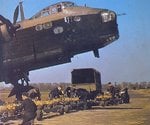Navigation
Install the app
How to install the app on iOS
Follow along with the video below to see how to install our site as a web app on your home screen.
Note: This feature may not be available in some browsers.
More options
You are using an out of date browser. It may not display this or other websites correctly.
You should upgrade or use an alternative browser.
You should upgrade or use an alternative browser.
RAF bomb colours
- Thread starter aircro
- Start date
Ad: This forum contains affiliate links to products on Amazon and eBay. More information in Terms and rules
More options
Who Replied?Airframes
Benevolens Magister
The yellow colour, which normally appeared as a washed-out pale yellow, was used up until roughly the latter part of 1942, although could still be seen on 250 pound bombs for some time afterwards. From then, and especially with the nwere types of bomb and specialised ordnance, the colour was Dark Green, with the tail unit (fins and cone) being in either black or a grey metal. Also, by mid 1944, many American bombs were alos on use, normally distinguishable by the twin suspension loops and 'square' fins, and these were in Olive Drab. Markings depended on fuilling, weight, type etc.
Other colours were used for Drill pieces, Practice, Smoke etc, and I believe there is a thread covering British ordnance and bombs somewhere here in the forum.
Hope this helps.
Other colours were used for Drill pieces, Practice, Smoke etc, and I believe there is a thread covering British ordnance and bombs somewhere here in the forum.
Hope this helps.
- Thread starter
- #3
Airframes
Benevolens Magister
It's doubtful (though not impossible) that a Federal Standard number can be found. As Britain didn't use the FS system, and the B.S.I. hadn't even been thought of, any colour reference, if there was one, would have been from the Air Ministry or, as the bombs, or their design at least, dated from the end of WW1, possibly even the War Office. It might be possible to find some form of colour refernce by digging in the archives of the RAF or Imperial War Museums, but to be honest, unless this is imperative and extremely important to research, I doubt the effort would be worthwhile. The results are likely to yield information along the lines of " aerial bombs are to be painted yellow.....". !!
If the need to know is for a modelling or art project, then I'd suggest that the colour was probaly the yellow used in the roundels of RAF aircraft from late 1939,being a paint 'in stock', and photo evidence suggests that this (on the bombs) varied considerably. This would be due to the initial painting, storage, exposure to the elements due to storage outdoors, and rolling around on the ground, handling etc.
If you need a colour picture example, let me know, and I'll post something here.
If the need to know is for a modelling or art project, then I'd suggest that the colour was probaly the yellow used in the roundels of RAF aircraft from late 1939,being a paint 'in stock', and photo evidence suggests that this (on the bombs) varied considerably. This would be due to the initial painting, storage, exposure to the elements due to storage outdoors, and rolling around on the ground, handling etc.
If you need a colour picture example, let me know, and I'll post something here.
- Thread starter
- #5
Airframes
Benevolens Magister
No problem. Leave it with me if you don't mind, as I'm having difficulty using my hands at the moment, due to flare-up of Rheumatoid Arthritis, so handling a book to scan is rather painful! I'll post something within the next day or so.
- Thread starter
- #7
Loiner
Senior Airman
Can I copy this info freely given on the finescal.com forum,


''My reference for these colors is Aviation News Vol 16/3.
2000LB MKII/III: dark green overall with 2 inch wide light green band 16inches from nose and a 1/2 inch wide red band 6 inches from nose
4000LB MKII: as above but light green band is 2 feet from nose and red band is 8 inches from nose
4000LB MKIII/IV: as above with blue band added to indicate American supplied
8000LB MKI/II: as above but bands on both sections of bomb, red band 1 inch wide
12000LB MKII: as above''
- Thread starter
- #9
Airframes
Benevolens Magister
Sorry for the delay, but here's a section of a well-known photograph, I think originally from Charles E. Brown, showing the colour. I should have some more from this series of shots of the Stirling, and I think also another colour shot of a Wellington being loaded, but of course, the colours are the same!
Attachments
- Thread starter
- #11
Users who are viewing this thread
Total: 1 (members: 0, guests: 1)

